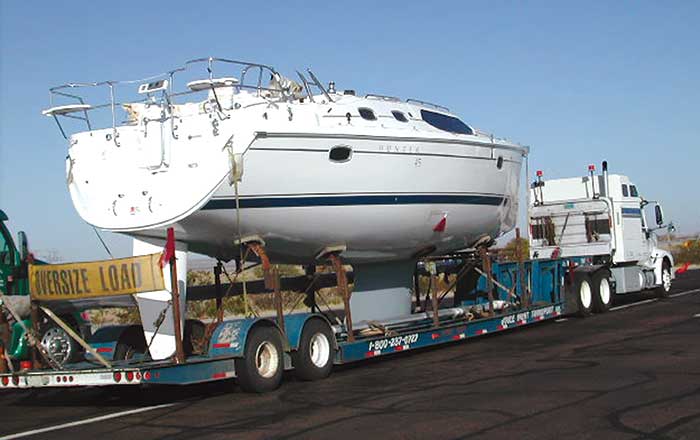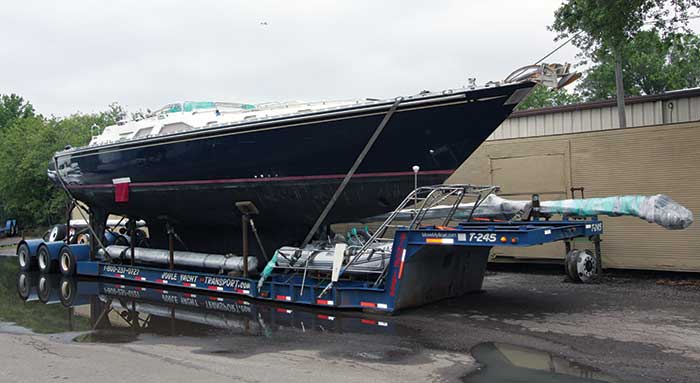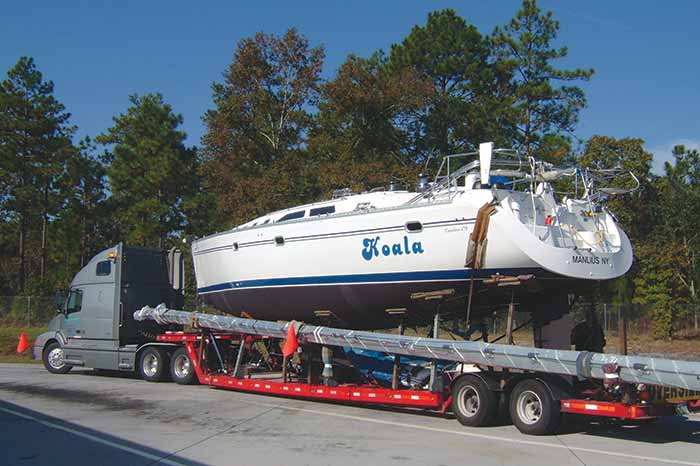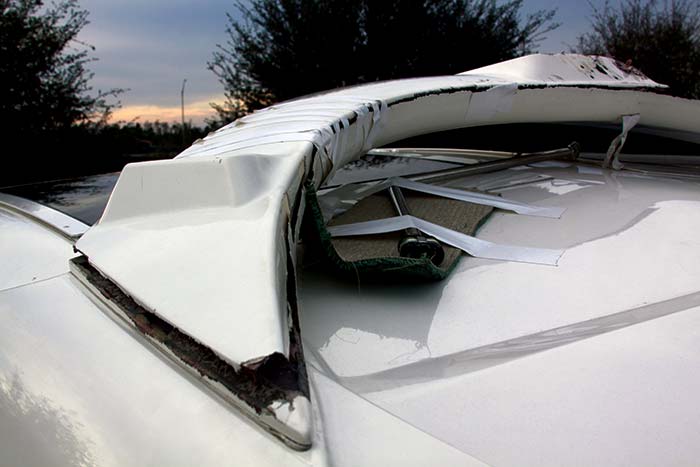Advertisement
What you need to know if you transport your boat overland.

Photo: Joule Yacht Transport
While most boat transports go off without a hitch, that's not always the case. A BoatUS member who wanted his 37-foot sailboat moved from Washington to Rhode Island had previously shipped his boat the reverse route and assumed a similar problem-free experience. But when the boat arrived, he noticed the boat's prop and shaft were damaged where it rested on one of the trailer struts, and the mast was gashed and mangled. He called the trucking company, hoping it would send an insurance adjuster to inspect the damage. After all, its advertisement claimed, "Insured for $1,250,000, which assures that your investment will be protected while it's on our trailers."
His first surprise came when the company said it doesn't use insurance for claims of less than $100,000 and handles them "in house." The company also wouldn't give him its insurance carrier's name. The second surprise was how it handled in-house claims. The company began trying to negotiate the claim and wanted to fix the mast itself, though it was obvious the mast needed replacement.
Eventually, the member had to hire a marine surveyor who, with the boatbuilder's input, helped get a repair quote from a local yard. The cost to repair his boat would cost more than $25,000, several times more than the transport cost, and the boat would be out of commission for weeks.
Finding A Shipper
Shippers, also called transportation service providers (TSPs), are state licensed and are issued an Operating Authority document by the U.S. Dept. of Transportation (DOT). In addition, TSPs must obtain vehicle insurance, and drivers must have commercial driver's licenses, which include testing requirements for drugs and alcohol. Equally important, they should have liability and cargo insurance to protect your boat.
Before hiring a company, ask to see the DOT or state documents and copies of the cargo insurance and verify they are up to date. Reluctance to provide this information is reason enough to look elsewhere. DOT makes it easy to check the status of commercial carriers' licenses, motor carrier insurance data, and safety ratings (see "Be Wary Of Online Shopping" below). Had the member known, he could have checked the DOT website and found his TSP failed a much higher percentage of truck inspections than average — an indication of sloppy maintenance and a big red flag.
Be Wary Of Online Shipper Shopping
Finding a transporter online may seem like a great way to save money, but beware. BoatUS has received numerous complaints from members who used bid-type clearinghouses to find transportation service providers (TSPs). For a fee, the websites allow you to enter your information and receive bids from several TSPs. In theory, you simply pick the best price and make the arrangements with the shipper. Unfortunately, the websites don't verify or validate the claims about experience, insurance coverage, and licensure made by trucking companies that are bidding for your business. They also won't help if you have problems with the shipper. Some members who posted negative reviews on one clearinghouse site found their comments had been deleted. If you decide to use such a service, use the same diligence you would if you called a shipper directly. Verify its status with the DOT, and get copies of the company's cargo insurance.
Choose a TSP that specializes in boat transport, not one that carries boats simply to fill its empty trucks. The transporter needs to know how the boat must be supported, balanced, and secured, and it needs experience working with state permit agencies because most larger boats exceed width restrictions and may be over the maximum height restriction. Ask the TSP if its driver is experienced transporting boats. Many companies contract out the driving to independent truckers; try to choose a company that uses experienced in-house drivers.
All transportation agreements should be in writing with complete information about costs, taxes, tariffs, scheduling, security, and pickup and delivery locations, as well as rules about refunds for cancellations or delays. Make sure you read the shipper's contract, and if you don't understand something, ask. Consult with an attorney if you're still unclear.
Prepare Your Boat Properly
The most important thing to know about preparing your boat is that it's not the job of the transport company. Unless they've agreed otherwise — and most don't — its job is simply to ship the boat from one point to another without damaging it. Smacking a low bridge at 60 mph will certainly damage a boat, but the GEICO | BoatUS Marine Insurance claim files show that the most common cause of shipping damage is due to improper or incomplete preparation, often things that aren't noticed until after the boat is delivered. Consider that your boat may be traveling down the highway in hurricane-force winds and experience road vibration for days. Your best bet is to use a boatyard experienced in preparing boats for transport. You'll have to pay for the service, but it can save you a big headache later. For larger boats, consider hiring a marine surveyor to supervise the preparations and coordinate with another one at the boat's destination to supervise the offloading and recommissioning.

Larger boats will likely need pulpits and stanchions removed. (Photo: Joule Yacht Transport)
Dana Holland, a senior GEICO | BoatUS claims adjuster, says, "Prepping the boat is critical." She's handled a lot of claims that resulted from damage during transport, so she knows what can go wrong. "When you hire someone to prep your boat for transport, get a contract in writing that specifies what they do," she recommends. So what should they (or you) do?
Canvas, frames, mast spreaders and lights, and other equipment on the masts should be removed. Stays and halyards should be removed or secured tightly to the mast — pallet wrap works well — and the entire mast should be wrapped in padding, such as carpet. Note that if the stays are left on, they may mark up the mast and it may be better to remove them, especially for a painted mast. On large powerboats, the flybridge will have to be taken off and may even be shipped separately. Bow and stern rails as well as stanchions may have to be removed if the boat is particularly tall.

This mast is well-protected and secured for travel. (Photo: Joule Yacht Transport)
Remove loose items from lockers and secure all locker doors; the boat may experience rough roads and sudden stops. All hatches must be securely dogged down and taped over from the outside to keep rain out. Keep in mind that your boat may be going down the road stern-first and will be subjected to unusual winds. Windshields may have to be removed. Dinghies must be removed from davits and transported below or shipped separately if they won't fit. Expensive electronics should be removed and shipped separately or securely stowed inside the boat with all access locked. Holland says, "Attend the preparation if you can and take lots of pictures of the boat — bow to stern and top to bottom, including the mast and hull supports — to show there was no prior damage. Set your camera to show the date."
Holland says, "Attend the preparation if you can and take lots of pictures of the boat — bow to stern and top to bottom, including the mast and hull supports — to show there was no prior damage. Take pictures of the inside of the boat, too, in case there is hidden damage such as a cracked bulkhead. Also, a quick walk-around video can help spot things your photos didn't catch. Set your camera to show the date." If there is some damage before the boat is loaded, she says, note it on the "condition of cargo" form the TSP will provide. Make sure the driver or a representative of the TSP signs it. Holland adds, "If you can, take a photo or video of the boat as it drives off. And when you pick it up, do not unload until you take pictures again from all sides." It doesn't hurt, she says, to have a third party as witness to any damage that will sign a document to that effect.
Some drivers, she says, will pressure you to simply sign off on the delivery even if there is some damage visible, saying their company will take care of it later. Don't fall for it. "Make notes on any forms you sign that there is damage and try report it to the company before accepting the boat," says Holland. One more thing she advises: If you note new damage at delivery, "get any details you can on the driver (name, license number, and so on) as well as the DOT numbers on the side of the truck, and take photos of the truck." Contract drivers with their own tractors may be hard to find later.
Even if your boat arrives undamaged, expect it to be dirty, especially if it's a long cross-country trip. Many TSPs recommend against shrink wrapping boats because it can be torn off and cause damage at high speeds.

This radar arch was too high to make it under a bridge. It's the owner's job to remove anything that might be too high. (Photo: Joule Yacht Transport)
Payment
Usually, a TSP will require a deposit up front, which is often necessary to get permits and escorts. Full payment is due at delivery, and shippers will probably not release the boat until they're paid, so arrange to have a certified check at the drop-off point if you won't be there. Some shippers will allow you to make a wire transfer.
If you can't be there for the drop-off, make sure someone you trust can make a thorough inspection and take photos and videos of the outside and how the boat and its equipment were secured. It may have changed during the trip and should be noted. Emailing or sending the receiver a thumb drive with the before pictures you took makes it easier to spot problems. Keep in mind that delivery dates are approximate, and weather, traffic, or road construction issues can cause unforeseen delays. You may need to coordinate a new schedule at the drop-off point.
What To Do If Something Goes Wrong
If you hired a marine surveyor to supervise the loading, arrangements should be made for a local surveyor to check over the boat on arrival. If you wait for the boatyard to inspect the boat as it's being reassembled, you won't be able to document any problems before the driver leaves. Whoever does the inspection should go over the boat inside and out, make a detailed report, and have the driver sign it. The driver may have his own condition report, but make sure he gets a copy of yours and you get a copy of his.
Most TSPs require the shipping to be paid even if there is damage, and the driver probably won't release your boat until he's paid. Since smaller claims are usually handled without involving an insurance company, you may need to hire a marine surveyor to prepare an estimate and protect your interest. If you find the shipper reluctant to fix your boat, file a complaint with DOT, which investigates complaints about carriers.
If you are insured with GEICO | BoatUS, damage while shipping is a covered event. Holland says that if you find damage after shipping, call GEICO | BoatUS immediately to file a claim. The pictures you took may prove invaluable in settling the claim. GEICO | BoatUS Marine Insurance will then file a claim against the shipper or its insurance carrier. But keep in mind that if you are moving from one cruising area to another, you must notify your insurance carrier before you launch your boat.
Fortunately, the member above had a happy ending. He called GEICO | BoatUS and opened a claim. After sending a marine surveyor to inspect and estimate the damage, his insurance paid for the repairs and filed a claim against the shipper's insurance. Instead of dealing with what Holland says ended up as a prolonged negotiation with legal fees, the member got to enjoy his boat in a new cruising ground.
The Disappearing Boat
GEICO | BoatUS claims adjuster Dana Holland says that trying to get shippers to pay for damage can be a real struggle. Often the TSP, the driver, and whoever prepped the boat point fingers at each other. But that's not always the case. In one instance, she says a driver attempted to drive under a hotel overhang in Texas, which "decapitated" the boat. The driver unhooked the trailer and left it in the parking lot of the hotel. "We thought the boat had been stolen, but the driver simply drove off and left it there. We didn't find it until we started investigating," she says." "Fortunately," says Holland, "if you're insured with GEICO | BoatUS, the buck stops here, and we'll handle it for you."
